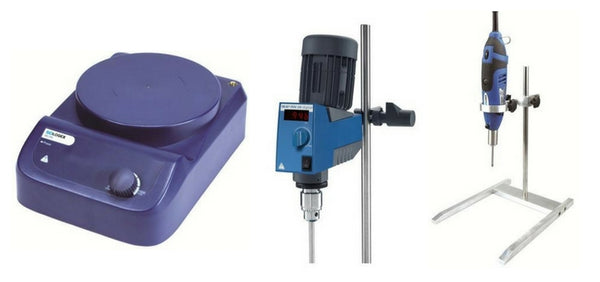The decision of whether to use a homogenizer or a stirrer seems as though it should be a straightforward one. Indeed, it often is. However, there can be cases where it’s not that black and white.
In this post, we’ll explore the factors related to this topic to help you make the right decision for your application.
Solubility of Components
One method to help determine whether or not a homogenizer is necessary is to consider the solubility of the components being mixed.
On this basis, if all components are soluble in the solvent, an overhead stirrer (or other type of stirrer) should do the job. All components will dissolve naturally once they are thoroughly mixed.
On the other hand, if one or more components are insoluble in the the solvent, then a homogenizer will likely be needed. Using a homogenizer, you can decrease the particle size to create a more stable emulsion or -- if solids are present -- suspension.
Desired Particle Size
We mentioned particle size above and this is another factor that could contribute heavily to your decision. If a large particle size is acceptable or desired, then a stirrer might be able to do the job. Even in cases where you have insoluble components, if the desired particle size is relatively large, a stirrer may give you enough shear to reach the desired particle size for your emulsion or suspension.
Conversely, if you need a small particle size, then a homogenizer will likely be required.
So what’s the cut-off? Our subject matter expert, Carlton Hoyt, weighed in on this:
"The line at which you would choose a rotor-stator homogenizer, or a homogenizer at all, versus something like an overhead stirrer, isn't a cleanly defined point. If you forced me to to draw a line, I would say the cutoff might be around 100 µm for emulsions and perhaps 300 µm for suspensions. I wouldn't expect an overhead stirrer to get much below that, if at all, unless the substance was soluble in the solvent being used.”
Type of Stirrer or Homogenizer
As mentioned earlier, once you’ve decided between a stirrer and a homogenizer, you still need to choose which type to use.
For stirrers, a magnetic stirrer won’t create much shear, but an overhead model fitted with the right impeller might do just fine.

Left to right: An MS-P Series magnetic stirrer, an RW 20 Digital overhead stirrer, and a D160 homogenizer.
When it comes to homogenizers, there are many different types and models to choose from. You can learn more about the different types and uses in our Homogenizer Application Center.
